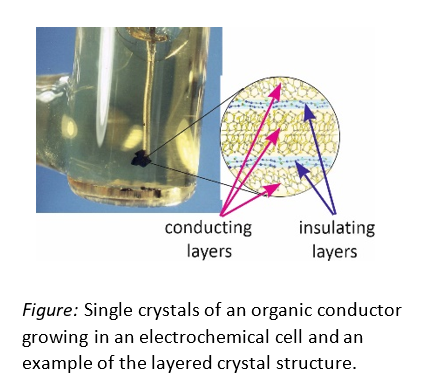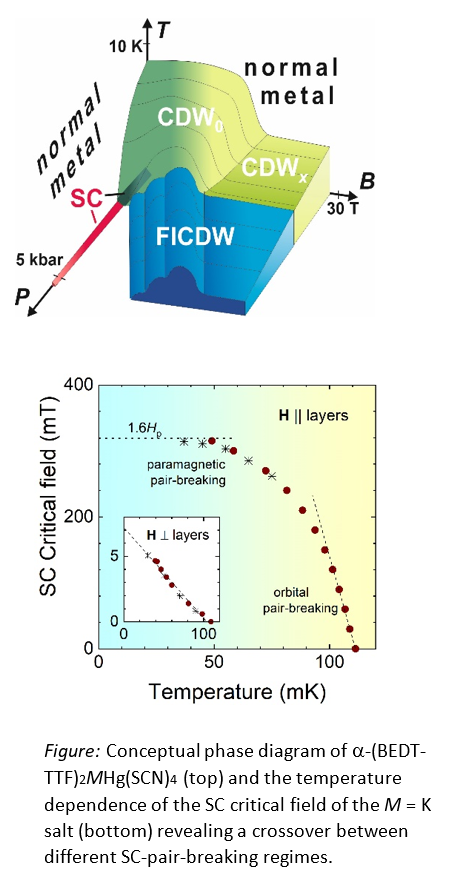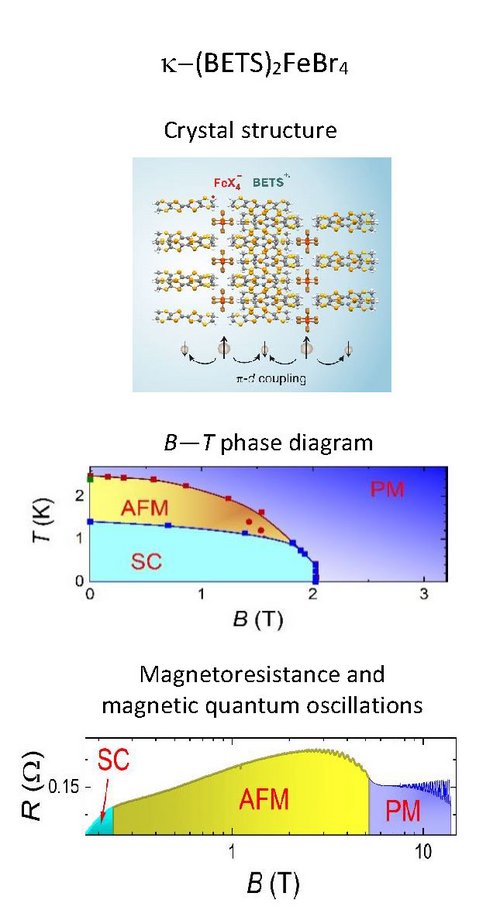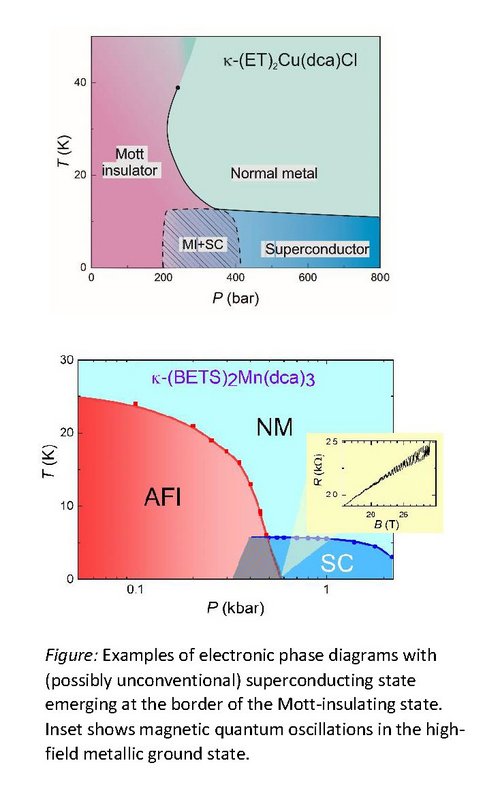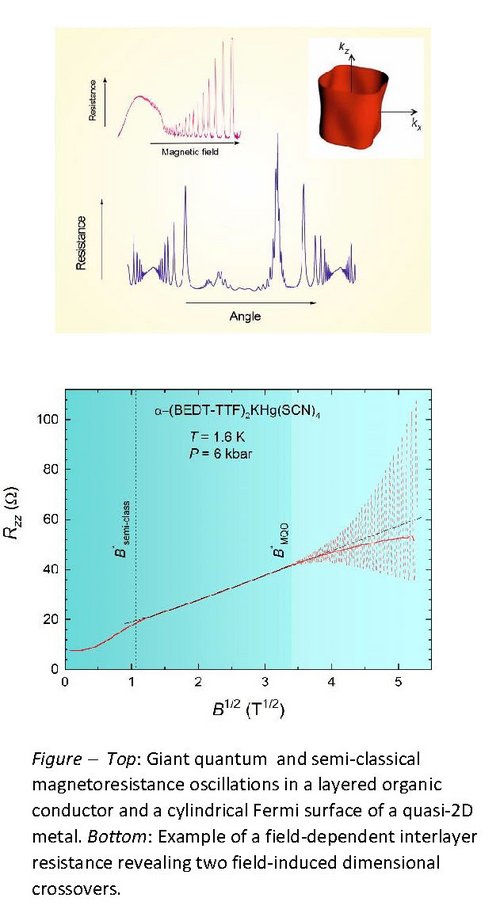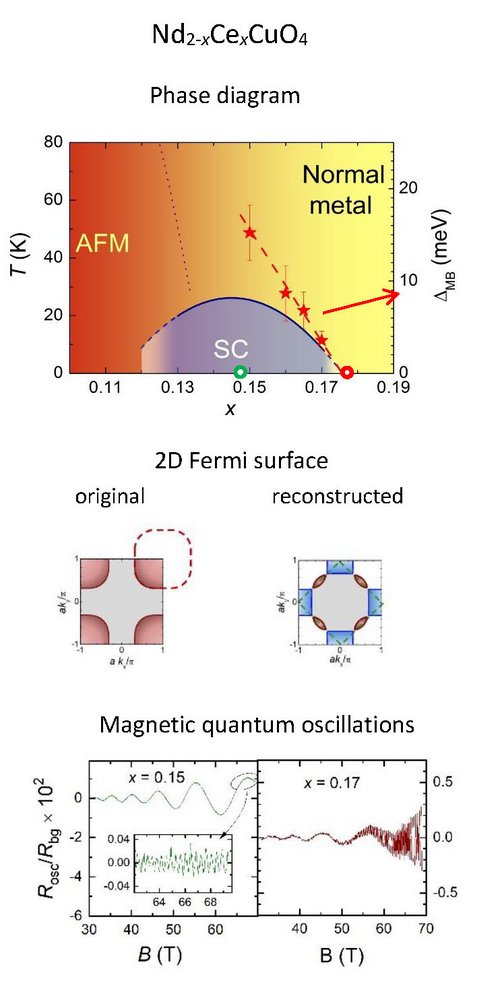Organic Metals and Superconductors
From the everyday experience one normally identifies organic materials as electrical insulators. However, there is a class of synthetic molecular charge-transfer salts, which exhibit metallic conductivity, some of them being even superconductors.
The key common features of these crystalline organic metals,
- extremely high electronic anisotropy: quasi-one & quasi-two-dimensional conduction bands,
- strong electron-electron and electron-phonon interactions,
give rise to very rich electronic phase diagrams and fascinating phenomena such as charge- and spin-density waves, quantum electric-dipole- and spin-liquid states, topological excitations, etc. Of special interest is the emergence of superconductivity in close proximity to various insulating ground states, similarly to what happens in other exotic superconductors like high-Tc cuprates, iron-pnictides and chalcogenides.
Sharing many properties with other topical correlated-electron compounds, organic metals have several advantages, which makes them particularly convenient model systems in the quantum materials physics:
- simplicity of the electronic band structure: a single quasi-1D or quasi-2D conduction band or a combination of both;
- high tunability of the system: different electronic ground states can be achieved upon applying a moderate pressure or magnetic field or a subtle chemical modification;
- intrinsically high crystal quality.
Our research is aimed at revealing the nature of different electronic states in layered organic metals and their relation to the, possibly unconventional, superconductivity. We focus on the salts of the organic donor molecule BEDT-TTF and its derivatives producing the largest number of organic superconductors.
We study transport and magnetic properties of these compounds, applying high pressures, strong magnetic fields, and low temperatures to drive a material through various states in the phase diagram. Special focus is made on high-field magneto-oscillatory phenomena as powerful tools for exploring the Fermi surface and other key characteristics of the conduction system.
Selected Research Topics
Charge-density Waves and Superconductivity
The salts alpha-(BEDT-TTF)2MHg(SCN)4 with M = K, Tl exhibit a rich phase diagram including various charge-density-wave (CDW) and superconducting (SC) states, depending on temperature, pressure, and magnetic field. At low pressures the CDW state dominates. It is sensitive to magnetic field, exhibiting a number of very interesting novel phases including
- a high-field hybrid charge/spin-density wave
- a series of quantum field-induced CDW (FICDW) phases.
At high pressures the CDW state is destroyed, giving way to an extremely anisotropic SC state. The huge anisotropy, combined with the very high crystal quality makes our materials plausible candidates for realizing:
- the long sought-after Fulde-Ferrel-Larkin-Ovchinnikov (FFLO) state with a spatially modulated order parameter;
- an unusual transition between type-I and type-II superconductivity driven by a change of the field orientation.
Below a critical pressure of @ 2 kbar, the CDW and SC phases coexist. Surprisingly, the SC critical temperature is not suppressed but significantly increases in this inhomogeneous state! This suggests an unconventional mechanism of SC pairing associated with CDW fluctuations.
Recent publications:
Magnetic quantum oscillations in the charge-density-wave state of the organic metals a-(BEDT-TTF)2MHg(SCN)4 with M = K and Tl
M.V. Kartsovnik, V.N. Zverev, D. Andres, W. Biberacher, T. Helm, P.D. Grigoriev, R. Ramazashvili, N.D. Kushch, and H. Müller
Low Temp. Phys. 40, 377 (2014); URL: https://aip.scitation.org/doi/10.1063/1.4869592
Magnetic field effects on the charge-density-wave and superconducting states in pressurized a-(BEDT-TTF)2KHg(SCN)4
M.V. Kartsovnik, W. Biberacher, D. Andres, S. Jakob, M. Kunz, K. Neumaier, H. Müller, and N.D. Kushch
Physica B 407, 1919 (2012); URL: https://www.sciencedirect.com/science/article/pii/S0921452612000695?via%3Dihub
Field-induced charge-density-wave transitions in the organic metal a-(BEDT-TTF)2KHg(SCN)4 under pressure
D. Andres, M. V. Kartsovnik, W. Biberacher, K. Neumaier, I. Sheikin, H. Müller, and N. D. Kushch
Low Temp. Phys. 37, 762 (2011); URL: https://aip.scitation.org/doi/abs/10.1063/1.3670031
Conducting/Magnetic Hybrid Materials
Hybrid materials combining nontrivial conducting and magnetic properties are of high current interest due to potential spintronic applications. Furthermore, they present important fundamental physics, especially in relation to high-Tc superconductivity, where a complex interplay of multiple electronic and magnetic components is a key feature of many cuprate and iron-based superconductors. In this context, some layered organic conductors containing transition-metal ions provide perfect natural heterostructures, where conducting and magnetic subsystems are separated in space but strongly interact with each other because of the nanometer scale of this separation.
We study quantitative and qualitative effects of the localized spins on the conducting system and vice versa by employing magnetic quantum oscillations of resistivity and magnetization. Of particular interest is the unusual interplay between magnetism and superconductivity: contrarily to common expectations, we can protect or even trigger superconducting pairing by aligning the localized spins in an antiferro- or ferromagnetic manner.
Recent publications:
Experimental evidence for Zeeman spin–orbit coupling in layered antiferromagnetic conductors
R. Ramazashvili, P. D. Grigoriev, T. Helm, F. Kollmannsberger, M. Kunz, W. Biberacher, E. Kampert, H. Fujiwara, A. Erb, J. Wosnitza, R. Gross, and M. V. Kartsovnik
npj Quantum Mater. 6, 11 (2021); URL: https://doi.org/10.1038/s41535-021-00309-6
Resistive properties and phase diagram of the organic antiferromagnetic metal κ-(BETS)2FeCl4
M. Kunz, W. Biberacher, N.D. Kushch, A. Miyazaki, and M.V. Kartsovnik
Phys. Rev. B 94, 205104 (2016); URL: https://journals.aps.org/prb/abstract/10.1103/PhysRevB.94.205104
Interplay between conducting and magnetic systems in the antiferromagnetic organic superconductor κ-(BETS)2FeBr4
M.V. Kartsovnik, M. Kunz, L. Schaidhammer, F. Kollmannsberger, W. Biberacher, N.D. Kushch, A. Miyazaki, and H. Fujiwara
J. Supercond. Nov. Magn. 29, 3075 (2016); URL: https://link.springer.com/article/10.1007/s10948-016-3829-z
Mott-insulating State vs. Superconductivity
The Mott metal-insulator transition is one of the fundamental hallmarks of electronic correlations in a metal. Unconventional superconductivity and other fascinating phenomena often emerge in close proximity to the Mott-insulating state. Our studies are aimed at a comprehensive understanding of the complex influence of the charge, spin, and lattice degrees of freedom on the charge-carrier properties near the Mott instability and adjacent, possibly unconventional, superconductivity.
As a testbed for our studies, we employ the family of k-type salts of BEDT-TTF and BETS with effectively half-filled conducting bands. Strongly anisotropic magnetotransport and quantum oscillations provide us tools for tracing the evolution of the conduction system and testing the validity of various theoretical models.
Recent publications:
Fermi surface properties of the bifunctional organic metal κ-(BETS)2Mn[N(CN)2]3 near the metal-insulator transition
V. N. Zverev, W. Biberacher, S. Oberbauer, I. Sheikin, P. Alemany, E. Canadell, and M. V. Kartsovnik
Phys. Rev. B 99 (2019) 125136; URL: https://journals.aps.org/prb/abstract/10.1103/PhysRevB.99.125136
Shubnikov–de Haas oscillations and electronic correlations in the layered organic metal k-(BETS)2Mn[N(CN)2]3
M.V. Kartsovnik, V.N. Zverev, W. Biberacher, S.V. Simonov, I. Sheikin, N.D. Kushch, and E.B. Yagubskii
Low Temp. Phys. 43, 239 (2017); URL: https://aip.scitation.org/doi/10.1063/1.4976634
New radical cation salt k-(BETS)2Co0.13Mn0.87 [N(CN)2]3 with two magnetic metals: Synthesis, structure, conductivity and magnetic peculiarities
N.D. Kushch, O.M. Vyaselev, V.N. Zverev, W. Biberacher, L.I. Buravov, E.B. Yagubskii, E. Herdtweck, E. Canadell, and M.V. Kartsovnik
Synth. Metals 227 (2017) 52;
URL: https://www.sciencedirect.com/science/article/abs/pii/S0379677917300668?via%3Dihub
Interplay between the d- and π-electron systems in magnetic torque of the layered organic conductor κ-(BETS)2Mn[N(CN)2]3
O. M. Vyaselev, W. Biberacher, N. D. Kushch, and M. V. Kartsovnik
Phys. Rev. B 96 205154 (2017); URL: https://journals.aps.org/prb/abstract/10.1103/PhysRevB.96.205154
Quantum and Semiclassical Magnetotransport in quasi-2D Conductors
In our studies of highly anisotropic correlated electronic systems in organic conductors we are broadly using high-field semiclassical magnetotransport and quantum magnetic oscillations as tools for probing the key characteristics of the charge carriers. These tools are in turn extremely sensitive to the dimensionality and many-body interactions, exhibiting distinct features absent in usual purely 2D or 3D metals. Fortunately, the variety of organic conductors offers a number of compounds, which serve as perfect model objects for exploring this issue. We employ them for investigating fundamental consequences of the electronic anisotropy and many-body interactions for:
- the mechanism of the interlayer charge transport;
- magnetic-field-induced dimensional crossovers;
- the behaviour of magnetic quantum oscillations.
Recent publications:
Experimental evidence for Zeeman spin–orbit coupling in layered antiferromagnetic conductors
R. Ramazashvili, P. D. Grigoriev, T. Helm, F. Kollmannsberger, M. Kunz, W. Biberacher, E. Kampert, H. Fujiwara, A. Erb, J. Wosnitza, R. Gross, and M. V. Kartsovnik
npj Quantum Mater. 6, 11 (2021); URL: https://doi.org/10.1038/s41535-021-00309-6
Shubnikov–de Haas oscillations in the magnetoresistance of layered conductors in
proximity to the topological Lifshitz transition
V. G. Peschansky, M. V. Kartsovnik, and S. Fust
Low Temp. Phys. 44, 791 (2018); URL: https://aip.scitation.org/doi/10.1063/1.5049160
Magnetic-field-induced dimensional crossover in the organic metal a-(BEDT-TTF)2KHg(SCN)4.
P. D. Grigoriev, M. V. Kartsovnik, and W. Biberacher
Phys. Rev. B 86, 165125 (2012); URL: https://journals.aps.org/prb/abstract/10.1103/PhysRevB.86.165125
High-Tc Cuprate Superconductors
The methods we are developing and using for exploring organic conductors, can be transferred to other materials of topical interest. Recently, the high-field magnetotransport and magnetic quantum oscillation techniques have proved to be extremely efficient in the field of high-temperature superconductors, which share important features, such as strong anisotropy and electronic correlations, with organic conductors. In recent years, we have carried out a series of high-field magnetotransport experiments on the electron-doped cuprate superconductor Nd2-xCexCuO4 (NCCO), studying
- its electronic phase diagram and
- the evolution and reconstruction of its Fermi surface upon carrier doping.
For example, our combined study of the magnetic quantum oscillations in an antiferromagnetic organic metal and in optimally doped NCCO have yielded a compelling evidence of magnetic ordering as an inherent property of NCCO even at superconducting compositions. This result settles a long-standing controversy in one of the central issues related to the mechanism of superconductivity in these materials.
Recent publications:
Experimental evidence for Zeeman spin–orbit coupling in layered antiferromagnetic conductors
R. Ramazashvili, P. D. Grigoriev, T. Helm, F. Kollmannsberger, M. Kunz, W. Biberacher, E. Kampert, H. Fujiwara, A. Erb, J. Wosnitza, R. Gross, and M. V. Kartsovnik
npj Quantum Mater. 6, 11 (2021); URL: https://doi.org/10.1038/s41535-021-00309-6
Magnetotransport evidence for irreversible spin reorientation in the collinear antiferromagnetic state of underdoped Nd2−xCexCuO4
A. Dorantes, A. Alshemi, Z. Huang, A. Erb, T. Helm, and M. V. Kartsovnik
Phys. Rev. B 97, 054430 (2018); URL: https://journals.aps.org/prb/abstract/10.1103/PhysRevB.97.054430
Correlation between Fermi surface transformations and superconductivity in the electron-doped high-Tc superconductor Nd2−xCexCuO4
T. Helm, M. V. Kartsovnik, C. Proust, B. Vignolle, C. Putzke, E. Kampert, I. Sheikin, E.-S. Choi, J. S. Brooks, N. Bittner, W. Biberacher, A. Erb, J. Wosnitza, and R. Gross
Phys. Rev. B 92, 094501 (2015); URL: https://journals.aps.org/prb/abstract/10.1103/PhysRevB.92.094501
Contact
For further information and possible topics of a Bachelor/Master/PhD thesis please contact Mark Kartsovnik.

